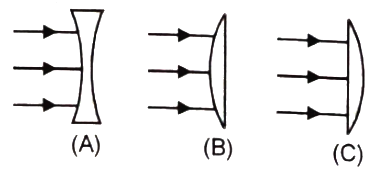What should be the maximum angle of acceptance at the air core interface of an optical fiber, if are the refractive indices of the core and the cladding respectively?
(1)
(2)
(3)
(4)
| 1. | \(80~\text{cm}\) | 2. | \(40~\text{cm}\) |
| 3. | \(60~\text{cm}\) | 4. | \(20~\text{cm}\) |
Two positions of the convex lens for which the image of the object is formed on the same screen are 40 cm and 80 cm from the object. The focal length of the lens is
1.
2.
3. 40 cm
4. 80 cm
| 1. | \(f' = f\) |
| 2. | \(f'<f\) |
| 3. | \(f'>f\) |
| 4. | The information is insufficient to predict |
A person cannot see objects clearly that are closer than 2 m and farther than 4 m. To correct the eye vision, the person will use:
(1) Bifocal lenses of power -3.5 D and 0.25 D
(2) Bifocal lenses of power -0.25D and 3.5 D
(3) Bifocal lenses of power -0.5D and 4.0D
(4) Bifocal lenses of power -4.0D and 0.5 D
A graph is plotted between the angle of deviation in a triangular prism and the angle of incidence as shown in the figure. Refracting angle of the prism is:
1. \(28^\circ\)
2. \(48^\circ\)
3. \(36^\circ\)
4. \(46^\circ\)
Minimum distance between real object and image produced by a concave mirror of focal length 20 cm is:
(1) 80 cm
(2) zero
(3) 20 cm
(4) 40 cm
Three lenses A, B and C are shown in the figure. Lens A is concave lens. B and C are plano-convex lenses. All the lenses have same focal length f. In which case the spherical; aberration is minimum?

1. A
2. B
3. C
4. All of the above
A small air bubble is present exactly at the centre of a glass sphere. Size of the image as seen from outside is of
(1) Same size
(2) Bigger
(3) Smaller
(4) May be smaller or bigger depending on the distance of observer
Three identical thin convex lenses are kept as shown in the figure. A ray passing through the lenses is shown. The focal length of each lens is

1. 5 cm
2. 10 cm
3. 15 cm
4. 20 cm







